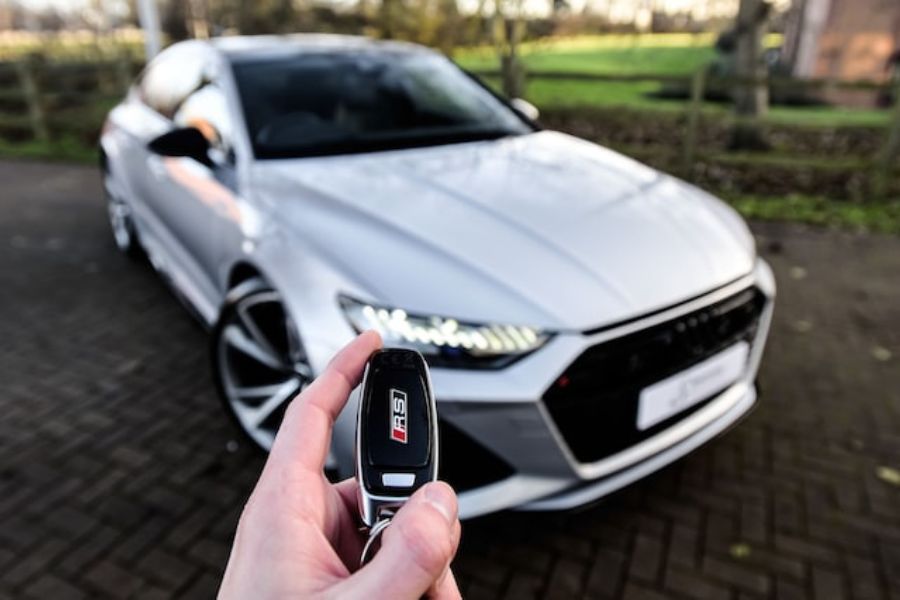Quick Navigation
Are you wondering why your car remote starts flashing blue light?

A remote start is a feature that allows a vehicle to be started remotely, usually using a key fob or smartphone app.
The function of a remote start is to enable the car to start and warm up or cool down before the driver gets in.
Flashing blue light in your car’s remote start is rare on vehicles, especially if the system is not installed.
In this article, we will talk through why your car’s remote is flashing blue light, its causes, and what you should do about it.
To ease your worry, keep reading and apply our tips!
What Does Flashing Blue Light in Remote Start Mean?
Flashing blue light on a remote start system indicates that it is in programming mode and is ready to receive a signal.
When you press the button on your remote to start the car, the light indicates that the remote start system received the signal.
It will then start the engine. It is a visual indication that the system is working correctly.
Once the engine has started, the light will stop flashing, and the car will be running.
If the light continues to flash after the engine starts, it may indicate a problem with the remote start system, or the vehicle’s security system.
It’s important to consult the vehicle’s manual or contact the manufacturer for further information and possible troubleshooting steps.
In some cases, it depends on the car model if the remote start system is installed.
The flashing blue light could also indicate that the remote start system is in valet mode, or that the system has been enabled or disabled.
It’s always best to refer to the car’s manual or contact the manufacturer for more information.
It has instructions on specific features and indicators of the remote start system installed in your vehicle.
There are several factors why flashing blue light happens on your remote start.
It could mean other factors if it does not stop flashing light after your engine starts.
Once it happens, your car may shut off shortly after starting.
Causes of Flashing Blue Light in Your Car’s Remote Start
A flashing blue light on a remote start can indicate several things. Some possible causes include the following:
Valet Mode: As mentioned earlier, a flashing blue light can indicate that the system is in “Valet Mode.”
Which is a temporary disabling of the remote start system and specific features. It is a safety precaution for your car to avoid moving.
Low battery: A flashing blue light can also indicate that the battery in the remote start key fob is low.
Or it needs to be replaced. If the battery needs replacement, replace it immediately.
Error/malfunction: A flashing blue light can sometimes indicate an error or malfunction within the remote start system.
Incorrect activation: A flashing blue light also indicates that the remote start has been activated incorrectly.
It may be by pressing the wrong button or sequence of buttons or that the vehicle is already running.
Always press the button correctly to avoid incorrect activation of your remote start.

Vehicle security system: Flashing blue light can be utilized as a dashcam or security camera.
It helps record when noise and motion are being detected. Sometimes it could mean an after-alarm for security purposes on your car’s dashcam or security camera.
Solutions on a Remote Start Flashing Blue Light
Here are some potential solutions for a flashing blue light on a remote start:
1. Exit Valet Mode and Check Security System
If the system is in Valet Mode, consult the vehicle’s manual or the manufacturer for instructions on how to exit this mode.
It may involve entering a code or performing a sequence of button presses on the remote starter key fob.
Ensure that you switched off the anti-theft or your security system safety feature to turn off the flashing blue light.
2. Replacing the Battery
If the flashing blue light indicates a low battery, replace the battery in the remote starter key fob.
It will help you assess if the flashing light is due to battery issues and no other factors.
3. Check the Connections
Check all the connections between the remote starter and the vehicle’s electrical system if it’s clean and secure.
Loose or unsecured connections can cause malfunction to remote starters including the continuous flashing of blue light.
4. Check the Remote Control
Check the remote-control panel if it’s properly working, to avoid malfunctions on your remote starter such as flashing blue light or not working at all.
5. Check the Vehicle’s Fuses and Relays
Ensure that the fuses and relays related to remote starter are secured to avoid flashing blue light malfunctions on your remote starter.
6. Consult the Manual or Manufacturer
If the flashing blue light indicates an error or malfunction, consult the vehicle’s manual or the manufacturer.
The manual provides a guide on troubleshooting steps and fixing the issue.
Also, check other factors to help diagnose whether the flashing blue light is due to an error or malfunction.
If you are not sure it is an error, it may require the attention of a professional to diagnose and fix the issue.

7. Contact a Professional
If the problem persists, it may be best to contact a professional mechanic or a remote start system installer for diagnosis and repair.
Having an experienced mechanic or installer to assess your problem will help you solve the problem efficiently.
It also ensures your safety in driving.
How To Prevent Flashing Blue Light on Your Remote Start?
Here are several steps that can help prevent a flashing blue light on a remote start:
Keep the remote start key fob battery charged: Regularly check the battery level of the key fob and replace it when it’s low.
Regularly checking your remote start battery level will prevent flashing blue light from occurring.
Follow the instructions: Review the vehicle’s manual or the manufacturer’s website instructions on how to properly use the remote start system, including how to exit Valet Mode, if applicable.
Avoid accidental activation: Be mindful of how the remote start system is activated. Also, avoid accidentally pressing the wrong button or sequence of buttons.
Regular maintenance: Maintaining the remote start system can help prevent errors and malfunctions that may cause a flashing blue light.
It includes checking the wiring and connections and ensuring the system is updated with the latest software.
Use a professional installation: If you plan to install a remote start system, it is recommended to use a professional installer.
It will ensure that the system is installed correctly to avoid any issues or errors in the future.
Conclusion
A flashing blue light on a remote start can indicate several things.
Such as the system being in Valet Mode, a low battery, an error or malfunction, incorrect activation, or the vehicle’s security system.
Some solutions include exiting Valet Mode, replacing the battery, consulting the manual, and contacting a professional for diagnosis and repair.
It is important to consult the vehicle’s manual or the manufacturer for troubleshooting steps and guidance to address the issue.
We hope that the tips we provided help you solve your problem in your remote start.
Also helps you understand what a flashing blue light on your remote start means.

James has been a car enthusiast since his childhood when he learned the differences between a ford and a chevy from his father. He loves to drive and restore old cars with a special drive for Italian marvels. Currently, he has a 1968 Alfa Romeo. He has studied aeronautics and civil aviation in his college and still gets smitten by Galant SS and Lancer GSR.
He is a New York-based product training director working with a giant automotive retailer. He loves to review and uncover the vehicles and their fascinating stories. He believes in keeping it legitimate with a keen passion for research on the latest technological upgrades in cars. While reading his articles or blogs, you can sense the extensive research and dedication backing the piece of text. He loves fried chicken, music, and spending quality time with his pet dog.







